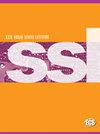Effects of Position of Exciton-Blocking Layer on Characteristics of Blue Phosphorescent Organic Light-Emitting Diodes
引用次数: 11
Abstract
In this study, we systematically examined the effects of the position of the exciton- blocking layer (EBL) in blue phosphorescent organic light-emitting diodes. The EBL was located either in the front and/or the rear of the emission layer (EML), and its effects to the device performances and electroluminescence spectra were investigated. The width and location of the recombination zone related to the triplet exciton quenching occurred in the devices with/without a front- or rear-EBL resulted in an optical micro-cavity effect in the EL spectrum at approximately 500 nm. The EBLs provided the direct, extra path of charge carriers from the hole transport layer (HTL)/electron transport layer (ETL) to the ETL/HTL through EML, resulting that the device operating voltage did not increase. The device with both front- and rear-placed EBLs exhibited the highest device performance, as triplet exciton quenching did not occur in it at the interface between the HTL/ETL and the EML.激子阻挡层位置对蓝色磷光有机发光二极管特性的影响
在本研究中,我们系统地研究了蓝磷光有机发光二极管中激子阻断层(EBL)位置的影响。研究了电子束位于发射层(EML)的前部和后部,对器件性能和电致发光光谱的影响。与三重态激子猝灭有关的复合带的宽度和位置导致了大约500 nm处的光学微腔效应。ebl为载流子从空穴输运层(HTL)/电子输运层(ETL)到ETL/HTL通过EML提供了直接的、额外的路径,导致器件工作电压没有增加。前后放置ebl的器件表现出最高的器件性能,因为在html /ETL和EML之间的接口处没有发生三重态激子猝灭。
本文章由计算机程序翻译,如有差异,请以英文原文为准。
求助全文
约1分钟内获得全文
求助全文

 求助内容:
求助内容: 应助结果提醒方式:
应助结果提醒方式:


